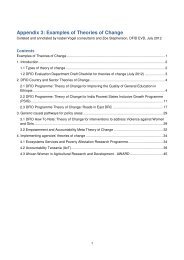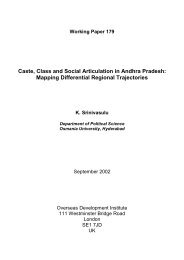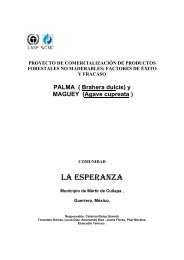Full Report - Research for Development - Department for ...
Full Report - Research for Development - Department for ...
Full Report - Research for Development - Department for ...
You also want an ePaper? Increase the reach of your titles
YUMPU automatically turns print PDFs into web optimized ePapers that Google loves.
Synthesis results<br />
of settings were also identified as a cause of non-implementation of breastfeeding<br />
and obstetric care. One example of this was the practice in some countries of new<br />
mothers sequestering themselves from most people during a culturally determined<br />
period after delivery, as in parts of India (Lim et al., 2010). Micronutrient shortage<br />
in pregnant women in LICs linked to low birthweight <strong>for</strong> infants was associated with<br />
morbidity and mortality (Kaestel et al., 2005).<br />
Cultural barriers remain a key determinant to lack of access to services (Lim et al.,<br />
2010) and to the implementation of appropriate health services/interventions<br />
(Jakobsen et al., 2008). Only one study (Lim et al., 2010) highlighted the<br />
inequalities in access to care to explain high rates of maternal mortality.<br />
The root causes of infant and neonatal negative outcomes were identified as<br />
pneumonia and diarrhoea mainly because of delays in vaccination (Martins et al.,<br />
2008), lack of antenatal care (Munjanja et al., 1996), and general lack of guidelines<br />
in breastfeeding <strong>for</strong> HIV positive women (Becquet et al., 2007; Kumwenda et al.,<br />
2008). Children born prematurely had compromised barrier functions which<br />
increased their risk of infection and of hypothermia (Darmstadt et al., 2008).<br />
4.2.2 Impact on health outcomes<br />
Only 7 out of the 21 studies reported a positive impact on health outcomes (Cobra et<br />
al., 1997; Taha et al., 1997; Dumont et al., 2005; Dumont et al., 2006; Darmstadt et<br />
al., 2008; Richard et al., 2008; Lim et al., 2010), of which five were related to<br />
maternal outcomes and three to infant and neonatal ones. The interventions<br />
included: skin barrier methods (Darmstadt et al,. 2008); death reviews and financial<br />
regulations (Dumont et al., 2005; Dumont et al., 2006; Richard et al., 2008 ); oral<br />
iodine supplementation <strong>for</strong> infants (Cobra et al., 1997); cash transfer schemes to<br />
improve institutionalised deliveries (Lim et al., 2010); and birth canal cleansing to<br />
reduce infections (Taha et al., 1997). Although we consider Kumwenda et al. (2008)<br />
as an overall neutral study, some of the clinical interventions did result in a positive<br />
impact on postnatal mortality.<br />
The range of interventions and specificity of the settings shows that no general<br />
conclusion can be reached on successful impact on health. Vaccination remains a key<br />
determinant of curbing infant mortality rates in resource poor settings. However<br />
what still needs to be further studied is the timing of vaccination. Martins Cesario et<br />
al. (2008) found no significant reduction in post-natal mortality in infants vaccinated<br />
be<strong>for</strong>e 9 months of age in resource-poor settings. However they suggested that an<br />
early two-dose strategy providing Edmonston-Zagreb vaccination (measles) as early<br />
as 4.5 months of age might be used in humanitarian emergencies or during outbreaks<br />
with a high risk of measles infection. A few studies suggested that there was<br />
insufficient evidence that changes in feeding practices did significantly reduce<br />
infection rates, as overall the effects might be counterbalanced (Kuhn et al., 2008) .<br />
However Becquet (2008) stressed that given appropriate nutritional counselling and<br />
care, access to clean water, and a supply of breastmilk substitutes, these<br />
alternatives to prolonged breastfeeding could be safe interventions to prevent<br />
mother-to-child transmission of HIV in urban African settings.<br />
4.2.3 Poverty and impact (sustainability)<br />
One study looked at the sustainability of intervention in low-resource urban settings<br />
(Figures 4.1 and 4.2): one controlled trial in Bangladesh identified a low-cost<br />
intervention that could be funded if necessary through out-of-pocket payments, <strong>for</strong><br />
emollient skin barrier therapy, although this still needs further testing (Darmstadt et<br />
al., 2008). Other interventions such as vaginal wash (Taha et al., 1997) were<br />
deemed to be low cost and sustainable, although this study is now over a decade<br />
old.<br />
What are the effects of different models of delivery <strong>for</strong> improving maternal and infant health<br />
outcomes <strong>for</strong> poor people in urban areas in low income and lower middle income countries? 47









